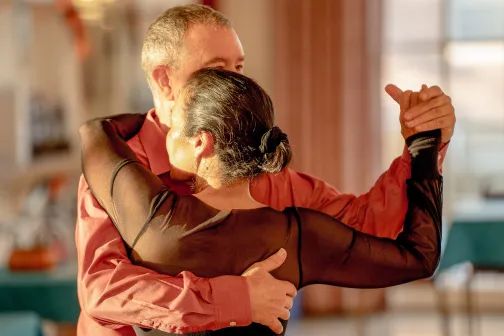I remember the exact moment I "groked" tango, the moment I suddenly got it. It was on my second trip to Buenos Aires, a couple of years into learning tango. Stepping out the door of the famous Confiteria Ideal, the music from the class echoed down from the open windows of the dance hall. I'm sure it was Anibal Troilo, probably "Milongueando En El 40" or "P'a Que Bailen Los Muchachos". Between one step and the other, tango music sunk its fangs into my heart.
Most of us are unfamiliar with tango music, so we have the cultural problem of learning all about a foreign genre of music with 50 or more years of history. Secondly, we have the problem of hearing the music, then embodying, expressing, and communicating the music with movements... all the while, navigating or walking around the room backwards in high-heels.
Similar to Jazz, tango has a rich and varied history, so where do you start? In swing dancing, you want to choose jazz music that "SWINGS", so in a similar way we need to ask what tango music "TANGOS"? The swing metaphor gives us a clue, because the great dance orchestras of tango cover the 1930s and 1940s just like the great swing orchestras.
The Golden Era of Tango: 1930 - 1955.
Argentine Tango is danced to the great orchestras of Buenos Aires from the 1930s, 40s and 50s. This was the "Golden Era" of tango. Modern tango music like Astor Piazzola is not used for tango dancing (except perhaps for performances). With the end of the dance generation in the mid-1950s much of the tango recording industry moved to "tango for export" (big lush orchestrations) or "nostalgic tango" (singers for concert halls), neither of which are very good for dancing. Osvaldo Pugliese, despite being one of the most complex, "big" and dramatic orchestras, is remarkable for maintaining a tie to the dance rhythms even into the 1960s.
Rough categories of tango music include:
- Guardia Vieja - prior to 1930s. Folk-sounding and usually poor recording quality.
- Guardia Nueva - 1930-ish. More complex Orchestration. "Dance-able" for some.
- Golden Era - 1930-ish to 1950. These are the glory years for tango orchestras and dancers.
- Tango for Export and Concerts - After 1955. The military coup shut down the night life, and with it tango dancing. Lush, big, orchestrations; Singers featured without much concern for dancers.
- Modern - Osvaldo Pugliese and Imitators. Pugliese is complex, but many pieces are loved for dancing. Other BIG orchestras are popular for performance tango.
- Modern - Revival of the Dance Sound arranged for social dancing.
Newcomers could profitably start by listening to the orchestras of Juan D'Arienzo from the 1930s and Carlos Di Sarli from the 1950s because the beat is solid and strong, and therefore easier to hear. Di Sarli is famous for emphasizing the steady, walking beat. D'Arienzo is rightfully called the "king of rhythm" because of the rhythmic, Quick-quick-slow he emphasized. As a dancer you need to have command of the walk, as well as rhythmic drive.
Francisco Canaro was hugely popular over several decades. His older material is more rhythmic, while his later recordings have a more lyrical sensibility. I love Canaro's waltzes, but in general, I prefer Edgardo Donato as I feel his style had more punch than Canaro.
The intensely dramatic and passionate music of Osvaldo Pugliese is the peak experience for many tango dancers. It can be athletic or slow and deep. In Buenos Aires, when they put on a Pugliese set toward the end of the evening, they turn the lights down low while everybody looks around for their favorite partner.
For more extensive tango CD listings, and discussions of different orchestras, see Stephen Brown's Guide to tango music for social dancing.






